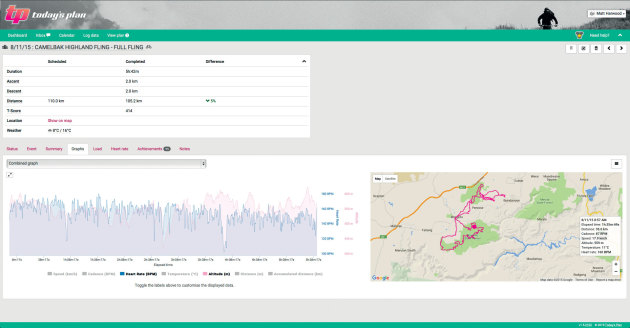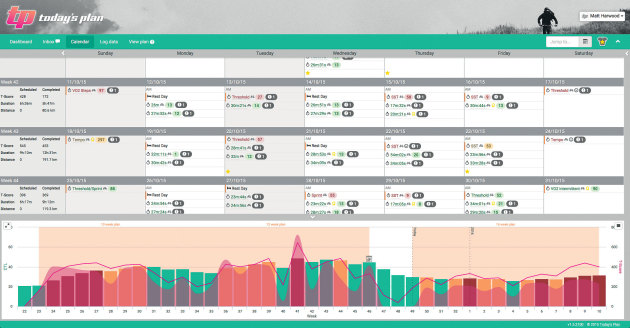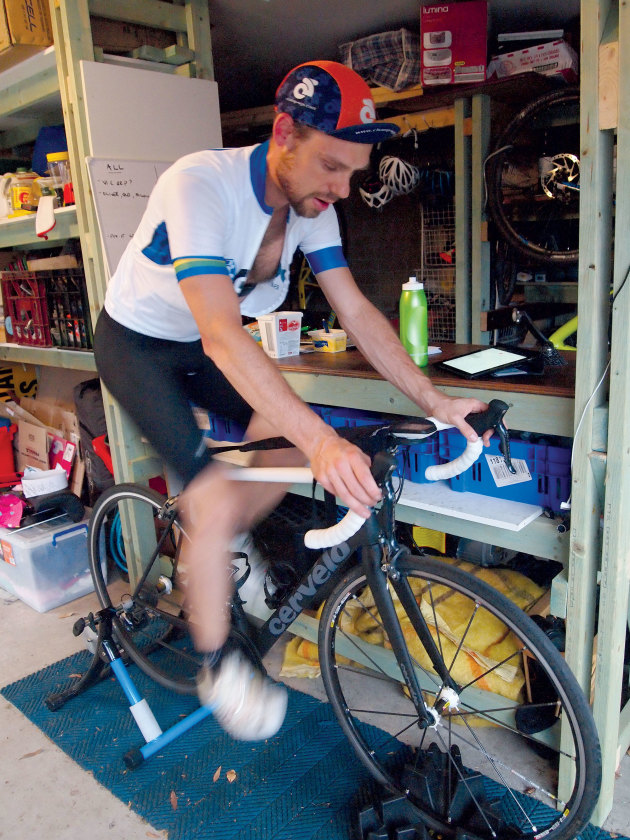I love marathon racing, absolutely love it! I’ve loved it since we called it ‘enduro’, not to be confused with #enduro. Big days out on the trail are great and as far as I’m concerned, you can’t have too much of a good thing. The personal and physical challenge that goes along with racing over a long distance carries a deep and irreplaceable satisfaction, as well as a little of that childish adventure element that even adults crave.
In years passed I probably spent 15 to 20 hours a week riding. Not necessarily training but simply getting from A to B and riding for fun. Life moves on however and circumstances shift; jobs, kids, locations, family and so on—I think many of you can relate! By my reckoning, I’m now a pretty typical family-guy mountain biker. Time pressed, always busy, sleep deprived and pretty tired under the facade of day to day functionality, but trying to remain active. Midway through 2015, I decided that I needed to drink a big sippy cup of concrete and get back in the racing mix.
My goal was the Highland Fling marathon race in the NSW Southern Highlands. I’d done this race four times before and really enjoyed it. I knew the event well enough to feel comfortable about slipping back into racing with that one.
At that point I was able to get in about five hours’ commuting each week. If I managed to get myself out of bed early enough to beat the family wake up and breakfast routine, I could possibly double my weekly ride time. Where possible I’d sneak out for a weekend trail ride and occasionally I could slip in a lunch time spin too. Once picked apart I had between five and 10 hours of ride time per week—I just needed to be on the ball and motivated to make it happen.
Personally I’ve never tried to race and be competitive in 100km MTB marathons with so little ride time and such a shallow and patchy base. For the first time I decided that I would need some kind of coaching to have any chance of doing okay. Problem was, I didn’t have time to go into a full on personal coach scenario, nor did I want to commit a large amount of cash. I’d heard about an Australian online training/coaching provider called ‘Today’s Plan’ and was familiar with some of the coaches behind it—we’ve often raced at the same events in the past.
A 12-week plan costs $60 which isn’t a huge expense when you consider the amount you’ll typically spend to enter the race, travel, eat and so on. So I signed up, kept some notes and learnt a lot along the way; both about training and also the pros, cons and practicalities of taking on a structured training program when you’re a busy suburbanite family guy.


Getting Started
Today’s Plan offer a 14-day trial, with no payment or even payment details required. Initially I signed up for this to have a play before getting started in earnest with my program. I’d suggest that anyone who’s planning to try it, or even just curious should take advantage of this option. There’s nothing to lose and it’s a good way to find out if the program is likely to work for you.
The Today’s Plan online platform offers all kinds of options. I used it as my coach, so it set my plan and helped to keep me on target, well most of the time anyway. It can also be used manually by coaches to set the programs for their athletes and athletes can set their own plans too. In all instances, the plans are entered into a digital calendar for tracking and editing. After a ride is done, you upload the data file from a Garmin or Magellan device to review the performance, track your longer-term progress and get feedback. For most recreational athletes, the Today’s Plan generated program would be the way to go, as you don’t need to have any idea what you’re doing—like me! It’s especially handy if you want to get specific and target a particular event.
To get started I needed to input information about my height, weight and gender as well as the bikes that I had available to train with. I nominated my ability level (definitely not ‘pro’) and told the system I wanted to do ‘single sessions’ as opposed to split sessions, the latter being the more logical option for commuting. It asked me to nominate the number of hours I had available each week, and then how many on each individual day.
With this personal profile info in place I then picked the duration of my plan. Sixteen weeks was the longest available and I was able to select my target event on the Today’s Plan calendar—the Highland Fling was already amongst the pre-loaded options. If you’re not targeting an event, you can select fitness goals such as climbing speed or endurance. A couple more clicks and my personalised plan was in the calendar, accompanied by a quick video clip explaining what to do. The set up was easy and very slick.
Your Digital Coach
Each individual session contains a description of the required intensity level and how it works your body. There’s also a brief instructional video that runs you through the efforts and what the session should feel like. Bullet points suggest suitable terrain for the session, and the actual session is set out clearly in a big table. This details each interval with the corresponding heart rate, cadence and power targets. A power meter will net the most accurate results but is not essential. I only had a heart rate monitor, and that’s really the minimum requirement to effectively follow the program.
There’s also a desktop plug-in to download; this lets your Garmin or Magellan device communicate with the Today’s Plan platform. With it, the workouts can upload and download automatically. If you have several rides saved from a single day, then it’s best to upload them manually; that way you can ensure the correct ride file is allocated to the corresponding workout in your schedule. There is also a beta stage Android app but no iOS version, so I’ve no insight on this option.
When a workout has been completed and uploaded, the platform provides some analysis. The easiest option to follow was the ‘T-score’; it’s basically a rating that reflects the duration and intensity of the workout. The higher the number, the harder. The workout comes with a target T-score and you’re instantly provided with your actual score to know if you should have gone harder or backed off. There are graphs showing your heart rate zones and limits, as well as all other data. For the seasoned rider there’s about as much analytics in there as you could want. Being a layman I just wanted to check my T-Score and the heart rate graph to see if I’d been hitting my targets—KISS principle all the way!

A long bar graph runs along the bottom of the main calendar screen. It shows the total training load for each week of your program, overlayed with what you actually achieved. Mine was all over the place! Instead of seeing a steadily climbing graph with a few dips for rest weeks, mine was more of a shark tooth profile.
The platform also sends an email each day with a summary of your session for the following day. This was great as I didn’t really need to think more than a day ahead. The calendar also allows you to drag sessions around if you need to. This was a common occurrence, as things came up and my riding opportunities got shuffled. If you do miss a session, the program doesn’t intelligently adapt or update.
Actually Training
The platform works well and is pretty easy to use, but it can’t do the training for you. There is the theory and your dream, and there is the harsh reality. So what’s it really like, could you do it?
In short, it was challenging. Everyone is different, but I really struggled to do my 10 hours of actual training per week. I could have selected less but I wanted to shoot high, as there were some weeks where I was able to meet my targets. Most weeks however, I fell short. I have to say that finding time was the hardest part, followed by the actual execution of the sessions.
Each training session follows very precise and narrow guidelines for heart rate (or power) and cadence. Doing them on the trail is close to impossible, except on fire road with a nice gradual climbing gradient. When an interval might last for 40 or 60 minutes it was even hard to find suitable roads in suburbia. This led me to find some new rides, and I also resorted to using a long cycleway with slow rolling knobby tyres to add resistance so I didn’t travel too fast. Outside of this, I mostly used the stationary trainer in my garage. My best executed workouts were all on the trainer, plus I wound up doing a number of late-night sessions that were squeeze in to make up for missed daytime opportunities.
After a few weeks I bought a cadence sensor and I’m glad I did. Once installed I realised my pedalling speed was way off. Now following the cadence recommendations, I found that the efforts were totally different.
I did have one major frustration with how the workouts were displayed on my Garmin. A workout file can’t display targets for two metrics – like heart rate AND cadence – but that’s exactly what you want to see. I ended up using my iPad to follow the sessions and just had it resting on the bench next to me. The Garmin was only used to display the live stats rather than to actually prompt my efforts.
Overall I felt shorter indoor trainer sessions achieved the most. They were up to 1.5 hours long, very specific and really time efficient. While they’re certainly not fun, they would be perfect for the dedicated but time pressed rider. I also found that you need enough spare time to ride ‘off the clock’. I missed a few sessions in favour of riding some fun trails. Not surprisingly this generates many more smiles than sitting on the trainer in the garage at midnight. Besides, mountain bike racing requires skills as well as a trained engine.
Previously I haven’t trained in a structured manner and I found the program improved my cadence tremendously. My pedalling is now way more fluid and I’m more likely to ramp up my pedalling speed rather than just jam it into a big gear and grind. I’ve also found myself slotting into a rhythm more automatically and I can feel when I’m pushing too hard. Overall it has heightened my awareness of what my body is doing, how hard I’m working and when I need to hold back.
I did feel as though my program lacked longer rides (says the time pressed bloke), which is something I wanted under my belt before race day; I’ve not had the chance to get on my MTB for five hours in one go for a couple of years. My program maxed out at three hours, so I emailed Today’s Plan to ask what to do. The email support was fast and also very helpful. I was able to add the rides into my schedule manually, and I was instructed which intensities to train at—thumbs up!
Race Day
In the week leading up to the race, the program scaled back with some easy rides and a little intensity before the race. I received emails telling me to be packed, ready, bike dialled and organised. I’ve done a squillion races before but this never hurts, and for a new rider the tips were really great. In typical fashion I ran out of time to complete my pre-race session the day before the race, which I was upset about but that’s how things roll sometimes.
The biggest revelation came a week prior to the race. It was the email alerting me to my upcoming race; the Half Fling—yes, the 50km half distance option. Computers can’t prevent stupidity, and I’d asked my faithful digital coach to train me for the Half Fling; that explained the lack of longer distances in my program! I was glad that I’d decided to insert the longer rides. After the race, I logged in and set-up a new program based around a 100km race in 16 weeks time, and presto: the longer rides were in my program and there were also longer durations for some of the higher intensity efforts.
The race rolled up and I felt pretty relaxed. I knew what intensity I should be riding at and where my red line and danger zones were—I just needed to obey the Garmin and let the race unfold as it would. For the first time ever, I raced with a cadence sensor. I did a reasonable job of resisting the urge to go out too hard; instead I slotted into my rhythm and employed my newfound higher cadence, although I did have my highest heat rates in the first quarter of the race. I wasn’t getting passed by all and sundry, in fact I was pretty happy with the pace I was keeping.
Most marathon races are punctuated by the sections of peak physical effort rather than highly technical riding, and the Fling is no exception. Two climbs are well known in the first half of the race. The first is known as ‘The Wall’, it’s short but very steep, followed by a few hundred metres of more gradual climbing. I managed to ride up with no real dramas whilst all around me walked. I gained a load of positions before the long section of singletrack that follows, which in turn prevented me from getting stuck behind slower riders—double win. I also recovered pretty well in the singletrack after a big effort up the Wall.
Later on, the ‘Halfway Hill’ is the real beast. The fastest guys go up it in a bit over 10 minutes, so it’s a decent pinch! The last time I raced, back in an era when I felt like I was pretty fit, I did it in a bit over 12 minutes—this was pushing hard without blowing totally. This time I followed my predetermined pace on the Garmin. After the first steep section I was able to get my heart rate under control whilst still climbing for another 10 minutes. The hill took 14 minutes but rode it with my own pre-meditated control. Not as fast as before but I certainly wasn’t as strong; if I’d tried to ride it aggressively, I’d have paid the price shortly afterwards.
Approaching the last quarter of the race, there’s a 10km open dirt road slog. Without a wheel to follow I rode this alone like a time trial. My cadence was great and I stayed right on the upper edge of what I could sustainably ride. I’d not have ridden this as smartly had I not had all that training time and practice.
In the last quarter of the race you face a number of pinches and I certainly felt like I was tiring. My legs kept to the program spinning a good cadence where I would have been out of the saddle grinding to keep the pedals turning in a past life. Again I rode up the steepest, loose pinches where those around me walked. I made up some time and dropped the riders that had been with me coming out of the last transition area.
I didn’t finish strong, but I did finish consistently and within a couple of minutes of what I’d thought was possible before the race. Comparing it with my last effort at the Fling; in both events I finished about an hour behind the elite winner. The last time I felt fitter and was riding a different style. I also lost well over five minutes to a few mechanical issues, so overall it was a stronger ride. Back then I also had at least 50% more riding time in the six months prior, fewer kids and much more sleep. Once adjusted for the differing preparation time, I think this year’s ride was a total success.
I definitely hold the Today’s Plan program responsible for this, the way I rode in terms of effort and control was a direct result of the work I’d done and the knowledge I’d picked up about my limits and how to ride within them. There’s no way that I would have been able to work as effectively in the time I had available if I’d just freestyled it, and I’ll certainly try to use some of the workouts I picked up in the future.
I’d love to stay with the program for an extended period to see the results, but it’s simply not practical for me. I’m happy to be back to just riding for the sake of it and not worrying about how I’m going to fit in another session. At the end of the day it’s about fun and being stressed about training is not something I’d choose to add to my plate.
On the flipside, if I had the kind of time I used to have and knew what effective training could achieve, I’d be all over it with a nice bit of time up my sleeve to just ride and have fun too. Taking on a program like this requires commitment. I tried my best, dropped the ball plenty of times, and still achieved what I feel are some tangible results.









